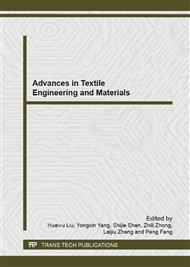p.298
p.302
p.307
p.312
p.317
p.321
p.325
p.329
p.333
Influence of Yarn-Reduction Technique on Bending Properties of Tapered 3D Braided Composites
Abstract:
The influence of distance between yarn-reduction cross-sections on bending properties of double-times yarn-reduction composites was investigated in this paper. Tapered 3D braided composites were prepared with the distances between two yarn-reduction cross-sections ranging from 1 pitch to 5 pitches. Bending properties in the center of the two yarn-reduction cross-sections were tested and the fracture morphologies were compared. Results show that damages mainly occur near the second yarn-reduction cross-section when the distances are 1 pitch to 3 pitches. However, obvious damages are found in the center of the two yarn-reduction cross-sections when the distances are 4 and 5 pitches. As the distances between yarn-reduction cross-sections increase from 1 pitch to 4 pitches, bending properties of the composites increase, too. For composites with 5 pitches distance, their bending properties are nearly the same as those of the composites with 4 pitches distance.
Info:
Periodical:
Pages:
317-320
Citation:
Online since:
December 2012
Authors:
Price:
Сopyright:
© 2013 Trans Tech Publications Ltd. All Rights Reserved
Share:
Citation:


